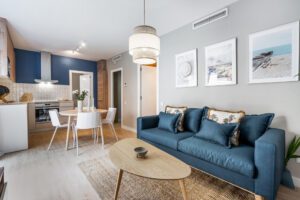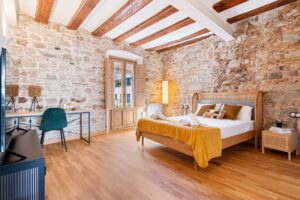As a manager of tourism apartments in Barcelona for 12 years, Lodging Management has seen its fair share of trends come and go. And no trend is more important for owners of holiday apartments than relative neighbourhood popularity. After all, what’s hot may change, but the location of an apartment does not. Today, an owner of a flat on Passeig de Sant Joan is probably celebrating, while someone in a formerly popular neighbourhood may be bemoaning the current state of affairs.
Ultimately, our advice to owners is that in Barcelona, a geographically small city with great public transportation, you shouldn’t ever worry too much. Just because Time Out has decided that Poblenou is the place to be doesn’t mean that your flat in Sant Antoni is going to be abandoned. The truth is that any visitor to Barcelona, whether a first-time tourist or someone here on a temporary 6-month contract, will have to traverse the city many times to see all the sights and experience everything Barcelona has to offer. Even if you only consider the most touristy of destinations (Montjuïc, the beach, the Sagrada Familia, Parc Güell, etc.), they are all located in different neighbourhoods, making it impossible to pick a truly “central” location in the city to rent.
What’s more, Barcelona is a city of neighbourhoods. While the centre, comprising Raval and the Gothic Quarter, has long been popular, every neighbourhood in Barcelona has its own feel, its own nightlife and restaurant offer, its own shopping, parks, and street life. Choosing a place to stay in Barcelona is about personal preferences, and these come in a very broad range of flavours.
To illustrate our point, we wanted to talk about some great experiences we’ve had managing tourism apartments and month-to-month rentals in what many consider “outlier” neighbourhoods like Sant Andreu or Zona Franca. Some of our owners and clients were concerned about their apartment’s rental potential, thinking that a visitor to Barcelona would never want to stay so far from the “heart” of the city. But Lodging Management is an agency that manages apartments all over Barcelona, including the centre, and we’ve found plenty of benefits to renting in these outlier neighbourhoods. Here are just a few:
A more authentic experience
About the drawbacks of Barcelona’s burgeoning tourism much has been said, not only by residents, but also by tourists themselves. In this era of experiential travel and tourists seeking authentic understanding of life abroad, it’s disappointing to come to Barcelona and not find any Barcelonins. Surely not everyone in the city is a hip multilingual DJ wearing Campers and heavily gelling their hair? The answer is of course not. That’s just a slim subpopulation, but one that might overrun some of the trendier nightlife destinations.
If you want a more accurate picture of Barcelona life, try one of the barrios previously mentioned. Here you’ll see kids playing football in the street, old women still doing their shopping with a trolley, people playing petanca, and neighbours having conversations between balconies. What you won’t see is a bunch of shirtless, drunken tourists looking for the quickest path to McDonald’s.
Cheaper (and sometimes even better)
Whether you’re talking about rents or the price of a good restaurant meal, Barcelona’s less central neighbourhoods can be a very interesting choice for travellers on a budget or those who simply don’t want to pay outrageous prices for hyped-up food of less-than-stellar quality. There are loads of traditional, decades-old restaurants in Barcelona’s neighbourhoods that, even if they haven’t received a write-up in a glossy magazine, are capable of delivering an astounding meal.
Great services and transportation
Barcelona being a city composed of neighbourhoods means that each of these neighbourhoods is pretty well self-contained. Markets, shops of all kinds, inter and intraneighbourhood transport, banks, pharmacies, gyms, and more, are all guaranteed to be within a comfortable distance. And some of these neighbourhoods are even more attractive than the centre for visitors who have to travel frequently. The Zona Franca, for example, is incredibly close to the airport, Montjuïc, and the cruise ship docks, while Sant Andreu offers easy access to the high-speed trains that take you all over Europe.
Space for everything, even cars
For anyone that’s ever tried to park a car in the centre or even the Eixample, you’ll know that this task, if not impossible, is certainly costly. With very little street parking, and then often only for residents, many find themselves relying on underground garages, which can be quite expensive. But in Barcelona’s more far-flung neighbourhoods, there is less of a premium on space, and cars are both welcome and easy to access. The same goes for floorspace. If it’s a large apartment you’d like to rent, without giving up cleanliness or amenities, look to some of these less densely populated neighbourhoods.
Views to die for
Barcelona runs down from the hills to the sea, and anyone at either of the extremes probably has a pretty astounding view of our little paradise on the Mediterranean. When you take account of the fact that you could wake every morning to the panorama of Barcelona’s beautiful skyline and the blue of the sea, does it really matter that you’ll have to ride the metro three extra stops when you decide to hit Barceloneta?
With just these few examples of the benefits we’ve found in managing holiday rentals in Barcelona in some of the outer neighbourhoods, we hope you’ll be inspired to open your mind to the great possibilities of these less tourist-ridden areas. Whether you’re a visitor looking for a different kind of experience, or an owner who’s been shy about putting your holiday flat on the market, it’s time to give these neighbourhoods a chance to shine.






